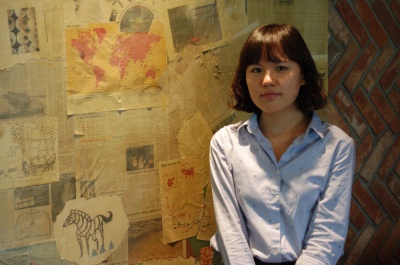Lee Sook-kyung, a young designer creating the future
WHAT CROSSES your mind when you hear the word "design"? Glamorous designer clothing or geometrically-shaped buildings will probably come to mind. However, these are only part of it. Lee Sook-kyung (Sr., Dept. of Visual Comm. Design, Wonju Campus), who is trying to launch her own design brand, is here to tell us what it truly means. With a firm conviction in her ability as a designer, she has achieved extraordinary things despite her young age. Her product, the "rescue stick," won the 2009 International Forum Design (iF) and Braun Prize International Design Award, and also took the silver prize in the International Design Excellence Awards (IDEA).
Choosing the path of a designer
When I was little, I, like many children, loved to draw. Growing up, I realized that I should learn more about art and pursue it as my career. Although I hoped to go to an arts high school, my parents were against it. So I graduated from an ordinary high school and entered a university, where I studied accounting. Nevertheless, due to my strong ambition to study visual arts, I dropped out of the school and joined a web design company, earning money and preparing for the entrance exam of the Dept. of Visual Comm. Design of Yonsei Univ.. It was the hardest time in my life, but I am satisfied with my decision.
Designing the rescue stick
The product for which I won the competitions was the "rescue stick," an improved version of existing life preservers*. While the current ones were inconvenient for children or women to use, the rescue stick is light and allows people to throw it more accurately from a distant place. When you throw it onto the water, the water flows into it, and the tube automatically opens up. It is also a lot cheaper than existing life preservers. Working on this project, I cooperated with students of KAIST and Chung-Ang Univ. in order to receive help on the engineering part of the design. I believe that the product aptly reflects both our collective efforts and the original thought we put into its design.
What design means to me
The person who has influenced my view on design is Victor Papanek. He does not pursue stylish or eye-catching designs, but he always considers the users' culture and environment along with the functional aspects of a product. He invented a radio made out of a tin can for the people in the third world, allowing them to listen to radio broadcasts and evacuate quickly in the case of an emergency. The radio components cost only nine cents but have saved thousands of lives. As this radio demonstrates, design should not only focus on improving the aesthetic quality of a product but also raise living standards.
My future
When I graduate Yonsei Univ., I will be finishing my internship in Samsung and preparing to study at a university overseas, possibly Carnegie Mellon. I am interested in interaction design, which may be unfamiliar to Koreans. It is a field aiming to provide consumers with greater convenience by designing the screen display or programs in devices like cell-phones or mp3 players. Since this is a field where new information is constantly generated, I believe that studying abroad is necessary.
* * *
Lee insisted that people should actively carve out their lives regardless of the circumstances or conditions they are in. While we cannot yet know how her career as a designer will turn out, she has a strong will to overcome challenges and step forward toward a brighter future. We can be confident that her passion will enlighten the world of design, and will improve society as well.
*life preserver: a buoyant jacket, belt, or other device for keeping a person afloat


